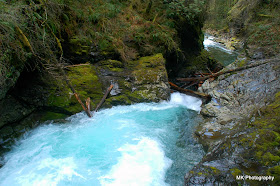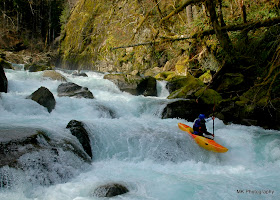~as told by Rob Cruser
20 years ago, my friend Scott Heesacker and I first started speculating about the feasibility of running the entire Sandy River in a single day. 5 or 6 weeks ago, after a trip down the newly remodeled McNeil Run on the upper Sandy, Jordan Englert started speculating about it on our way home, reviving my interest. There are quite a few factors that I knew had to come together to make this possible: 1) Lots of daylight, 2) Enough water to get down McNeil and not too much in the Gorge, 3) Minimal delays, i.e. portages, 4) Being able to carry or cache enough food and water for 45 miles of paddling and, 5) A small, compatible, motivated and mission-oriented crew. 4 out of 5 didn't turn out to be so bad.
I started assembling a willing crew of folks I knew and trusted: Jordan Englert (grew up on the mountain paddling the Sandy), Scott Heesacker (original idea man, firefighter, always up for an impossible adventure), Casey Heesacker (Scott's son, IK'd the Grand Canyon 4 years ago as a teenager), Rod Kilner (smoke-jumper, tough as nails, up and coming kayaker) and me, Rob Cruser. We started doing the math to see if it was theoretically possible and it appeared to be, barely. I did a time trial on the upper Sandy above Brightwood, and at a healthy flow, 5 miles an hour looked like the best we were going to do, with everything else being slower, sometimes much slower. So at best, averaging 3-4 miles an hour divided by 45 miles equals...hmmmm. Well, it didn't work out on paper, but we weren't paddling on paper, so we decided to at least give it a shot.
In the week prior, I scouted and marked the first few portages on the McNeil section to speed things along as this was going to be our slowest leg (10 portages or so, remember what I said about '4 out of 5?'). I also coordinated with our friend Mitch Williams - who lives at the Marmot bridge - for a lunch-stop and upper river shuttle logistics. We left a truck big enough to carry all of us and our boats at the take-out at Troutdale airport and another 'bail-out/food and water cache' van at Dodge Park. My biggest worry was the high level in the Gorge. It had risen to a pretty beefy flow the week before our run and it was slowly falling into what I hoped was going to be a reasonably friendly range. I have paddled the Gorge at least 30 times and higher than our level this day a couple of times, but that was a number of years ago and we had one first-timer and three second-timers for the Gorge, so I was a little nervous.
 |
| Put-in below McNeil bridge |
 |
| Nice rapid between first and second portage |
On Sunday, June 5th, we put-in just downstream from the McNeil bridge with one hardshell and four IKs (10.8/4000 or so on Bull Run gauge, high 2000's heading into the Gorge). Our goal was 7:30 AM, but it was more like 8:30 when we actually got on the water. Our first portage was 200 yards downstream, with the next one 200 yards below that, both of which went smoothly. We had an IK'er pin a couple of times in this, the most technical stretch, which slowed us down a tad. Further on, we had another IK'er slip getting out of his boat in a micro-eddy above a nasty log that was followed by a really nasty logjam. He got to shore but his boat took off and snagged under the first log. With some heroic work by Jordan out on the log, we were soon able to rope the wayward IK back to shore. Yikes.
 |
| Typical upper river scene on a lower water day. |
 |
| Jordan Englert getting a rope on a snagged boat |
 |
| Casey Heesacker waiting for a 'go' signal |
By the time we got to Lolo Pass, I sensed that time was slipping by too quickly. We cruised through the Lolo to Marmot leg and stopped at Mitch's house for lunch and water. When we passed under the Brightwood Bridge, a pedestrian asked us where we were taking out. I yelled back, 'The Columbia!' He gave us a 'shaka' and yelled 'Yeah!' I'm sure he didn't think we were serious, but we were glad for the encouragement anyway! So, it's about noon, we've covered maybe 10 miles with 35 to go...oh, well. I didn't think the math was going to work out in our favor at this point, but after a 1/2 hour break, we pressed on.
 |
| Somewhere near Alder Creek |
The run down to the old Marmot dam-site went well. As we approached the Gorge, Jordan and I started discussing the wisdom of continuing. There is a last-ditch bailout spot about 3/4 of a mile below '64 Logjam, so we decided to poke our noses in there and see how everyone felt at that point. As it turned out, a lot of the rapids were biggish but washed out some at this level, so it was actually fairly friendly and moving really fast. There were a lot of big holes scattered around, but also room to miss them. We did the far left cheat at Boulder, portaged Rasp Rock (ugly keeper at this level, the boulder on the downstream side was totally under water and backing up the hole and I had decided well in advance that we would walk this one) and Drain Hole. If we had just been doing the Gorge, we probably would have run Boulder center and some of us possibly Drain Hole, but we didn't have time at this point for scouting and indecision over who was going to run what and where and how to set safety, etc., so we opted for downstream progress. This same philosophy came into play at Upper Revenue, which we also skipped. This turned out to be a good call, since we had a scary event at Lower Revenue. Scott got surfed a bit at the entrance and ended up flipping in the big keeper on the bottom right. I had already run it and all I could see were his last few valiant paddle strokes and then his boat getting tossed unmercifully with no sign of Scott. Jordan, Casey and Rod could see him getting recirculated between the pocket against the right wall and the meat of the hole and were scrambling to get close enough for throw bags - not a good situation. Scott said he wasn't able to get any breaths in the aeration and violence, so after a couple of trips through the rinse cycle, he tucked and tried to go deep. Thankfully, this worked and he washed free and was able to get himself out on the left bank just above where I was eddied out under the bridge. His boat stayed in the hole for what seemed like 5 minutes before getting spit out. Scott had recovered by this point and jumped in and retrieved it as it went by.
 |
| "Scott's Hole" |
The hard stuff was done at this point, so now it was just a question of how much daylight we had left. It turned out we had made up a ton of time flying through the Gorge, so we were actually kind of back on schedule! At Dodge Park, we treated ourselves to another 1/2 hour break with food, water and chocolate covered espresso beans for an extra boost. Rod switched out of his IK into his hardshell at this point, nailing his first combat roll at the bottom of Pipeline - nice!
 |
| Casey and Rob at Dodge Park. The horses smell the barn from 18 miles away! |
With the sun still pretty high in the sky, we were in good spirits and feeling like we were going to make it. We still had about 18 miles to go, but without any foreseeable delays and plenty of current pushing us along. We made good time with minimal effort to Oxbow, but that's where the slog began. It wasn't exactly dead, but we were having to paddle our way through the flats and the coffee beans were starting to wear off a bit.
 |
| Scott and Rod loading up for the final push |
At Dabney, the flooding Columbia backed up the Sandy and turned the bottom 4 miles into a lake. Even at super-low flows in mid-summer, I have rarely seen absolutely no current on the lower river. At times I was sure it was actually running backwards. We were approaching 8:00 PM with plenty of daylight, so we knew we were going to make it, so it was just a question of exactly how tired and grouchy we would be when we did. Pretty tired, as it turned out, but everyone kept their grouchiness in check (even me!), which is one of the signs of a great crew. We ended up roping our boats up a steep bank adjacent to the east end of the runway at the Troutdale Airport and walked the last few hundred yards to the parking lot where high fives were exchanged and discussions of where to get lots of greasy food began. The slopes of Mt. Hood to Troutdale in one day...it still seems unreal.
This run would have been much easier and quicker, obviously, without 14 or so portages, but it amazed me that it was still possible with that being the case. Paddling with Jacob over the years has given me a new perspective on misery, and this wasn't nearly as bad as some of his 3-mile explorations (Gordon Creek or the Lower Little ***** at about 50 cfs for example), so I think I would definitely do it again. For those who might want to try it, I would say paddle the McNeil run shortly before you go to familiarize yourself with the current conditions there and be very comfortable in the Gorge, especially at high flows. Without the bigger flows in the Gorge, your trip from Revenue to the mouth would be excruciatingly slow. Not very many rivers offer you the opportunity to paddle from it's birth in the Alpine to it's mouth near sea-level in one day, so I would love to see more people try it. It's an epic, manageable adventure in our own backyard!







































